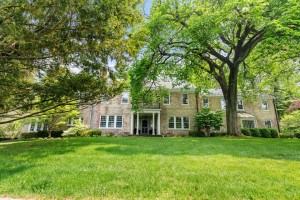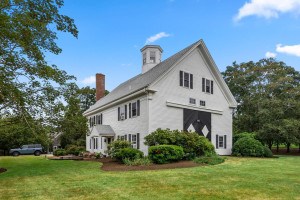Fall Real Estate Guide: City Living

From left, a renovated triple-decker in Southie, a classic South End townhouse, and the Residences at the Ritz-Carlton Towers. / Photographs by Matt Murphy/Boston Virtual Imaging
BUY
Dorchester
2015 Median Condo Price $345,000
2010 Median Condo Price $173,000
Five-Year Change 99%
Yes, median prices here have nearly doubled over the past five years. But Dorchester remains a savvy investment, with home costs vastly lower than in other well-located Boston neighborhoods. Meanwhile, its proximity to ultra-hot South Boston makes it more desirable than ever, says Lamacchia Realty’s Stacy Travers. “This is a smart buy for people who can’t afford Southie or the South End,” she says. In-the-know house hunters should zero in on North Dorchester, which could soon experience price spikes thanks to the upcoming Dot Block and South Bay retail and residential complexes. No matter where you settle down in Dot, however, one constant is location, location, location: “There’s proximity to I-93, Carson Beach, and downtown—you’re about 10 minutes from any point in the city,” Travers says.
East Boston
2015 Median Condo Price $320,000
2010 Median Condo Price $210,000
Five-Year Change 52%
For affordable waterfront living near downtown, Eastie might be your last great hope. “The median price is still under $500,000, trains offer fast transport downtown, and coming retail changes might be a game changer,” says local real estate agent David Bates, who notes that the Rapino Memorial Home at 9 Chelsea Street, near the Maverick T stop, will soon become a commercial development. Meanwhile, luxury condo buildings such as Seville Boston Harbor and Porter 156, with their waterfront views and roof decks, have attracted discriminating buyers. Coldwell Banker real estate agent Rich Hornblower recently listed a 1,734-square-foot Orient Heights condo for $679,000—“which had never been seen there before,” he says. In other words: Act fast.
Hyde Park
2015 Median Condo Price $211,250
2010 Median Condo Price $169,500
Five-Year Change 25%
Locals call it God’s country, and city slickers eager to live in Boston without the steep markup call it a godsend, says Realtor Kim Sullivan, of Pathway Home Realty Group. Hyde Park may be farther south than popular Jamaica Plain, but the location has kept home values lower—in fact, condo prices actually dropped by 18 percent from 2014 to 2015. “We see a lot of first-time buyers, especially people who can’t afford elsewhere in Boston and want to stay in the city,” Sullivan says. Buyers are also drawn to the tight-knit community feel and the architectural detail of the older housing stock. Want a suburban aesthetic with an urban ZIP code? Sullivan recommends looking in Fairmount Hill, which offers a “little more land and a Milton feel” complete with neighborhood restaurants and shops along Hyde Park and Fairmount avenues.
Translated: The Boston Listing
Ready to start the search? You’ll need to learn how to navigate the MLS. We asked local real estate expert David Bates, author of the Bates Real Estate Report blog, to give us a Hub-centric vocab lesson. —Brittany Jasnoff
South-Facing: Generally speaking, south-facing homes are desirable—it means they get plentiful sunlight during the day. But in the Back Bay, “it’s not uncommon for south-facing listings to face the rear of the building, the alley,” Bates says. Not exactly the breathtaking city view you’d been imagining.
Penthouse: Another potentially misleading term, especially for Back Bay listings. “It’s usually a highly desired location,” Bates says, “but if the building doesn’t have an elevator and getting to it requires walking up four to five stories, the unit can sit, as not many people will look to make the walk.”
Private Entrance: In the South End and the Back Bay, “it’s usually an indication that the condominium is on the ground or garden level, the lowest part of the building, and typically the least-valued space,” Bates says. Another dead giveaway? Letter (such as A or B), rather than number, designations in the unit description.
999 Square Feet: Agents, Bates says, will sometimes list a space at 999 square feet if a condo is so tiny that sharing the square footage will stop it from showing up in searches. “MLS is pretty flexible about how a condo’s living area has been determined, so buyers should take caution,” he explains. “It could be from public record, professional measurement, or what the owner said the size was. Sometimes it includes the basement, deck, or storage.” In other words: If it sounds too good to be true, it probably is.
Either-Or
Go for city convenience, or luxuriate in the wide-open spaces of the hinterlands? If you’re hunting for a high-priced slice of Boston to call your own, you’ve probably asked yourself that question more than a few times. Ahead, we compare listings at three price points, one in town and one miles away. Build your own conclusions. —Madeline Bilis

Photographs courtesy of Ruth Malkin Lerner (Brighton); Drum & Drum Real Estate (Maine)
| 110 Strathmore Road, #303, Brighton | $415,000 | 131 Bristol Road, Damariscotta, Maine |
| 702 sq. ft. 1 1 | Size Bedrooms Bathrooms | 2,900 sq. ft. 4 2 |
To choose between a Greek Revival near Maine’s rocky coast or a one-bedroom condo near Cleveland Circle is to choose between paying $143 and $591 per square foot.
In Damariscotta, a double wall oven is perfect for whipping up holiday meals. The Brighton listing’s galley kitchen, meanwhile, is a tighter squeeze. But the city condo does offer treetop views and a small communal grilling area—a fraction of the Maine home’s half an acre, but blessedly maintenance-free.

Photographs by Toan Trinh (Beacon Hill); courtesy of Candy Shiveley, Worcester Real Estate Photography (Spencer)
| 112 Pinckney Street, #1, Boston | $625,000 | 140 Paxton Road, Spencer |
| 724 sq. ft. 1 1 | Size Bedrooms Bathrooms | 3,470 sq. ft. 3 3 |
The winding back roads of Spencer have nothing on the cobblestone streets of Beacon Hill—except, perhaps, this lakefront farmhouse with nearly five times the space of the garden-level Pinckney Street condo currently on the market.
Whether you stay in the city or escape to the country, you’ll enjoy breathtaking scenery—on a shared roof deck overlooking the Charles on Beacon Hill (worth the price of admission alone), or along the sparkling Sugden Reservoir in Spencer, located just steps from the front door.

Photographs courtesy of Reitz Realty Group (Charlestown); Lila Delman Real Estate International (Rhode Island)
| 1 Warren Street, #107, Charlestown | $999,000 | 28 Berkeley Road, Warwick, Rhode Island |
| 1,264 sq. ft. 2 2.5 | Size Bedrooms Bathrooms | 5,071 sq. ft. 5 3 |
This Charlestown condo has amenities to spare: two garage parking spots, city and marina views, imported grass-cloth wallpaper and Italian tile. At first glance, there seems like no better way to spend a million bucks—that is, until you consider this sprawling estate in Rhode Island.
The Tudor-style manor offers poolside panoramas of Greenwich Bay at a mere $197 per square foot—four times less than what you’d pay for those urban vistas. Not to mention an elegant sunroom and a tennis court. Who says you can’t have it all?
SELL
South End
2015 Median Condo Price $800,000
2010 Median Condo Price $545,000
Five-Year Change 47%
“Now’s the right time to take advantage of South End bidding wars,” Hornblower says. With a five-year median-price increase that beats other prime neighborhoods like the Back Bay (43 percent) and Beacon Hill (21 percent), the neighborhood is still on the upswing. Just don’t wait too long to hang that for-sale sign: As buyers increasingly begin to favor the modern amenities of shiny new high-rises elsewhere in the city, the appetite for the South End’s historical inventory could soon slow down. “For the first time in a number of years, Boston residents have an opportunity for two different types of lifestyles,” Hornblower says. “One the full-service building and one being the more traditional brownstone type of building.”
Roslindale
2015 Median Condo Price $369,500
2010 Median Condo Price $270,000
Five-Year Change 37%
If you landed in affordable Roslindale a few years ago, now’s a good time to trade up. Why? The demand for homes is higher than ever, thanks to house hunters priced out of J.P., where condos sell for nearly $100,000 more. As a result, Rozzie prices have surged, up 37 percent in five years for condos and 39 percent for single-families, which can only help families looking to offload a starter home for a profit. Take the Walter Street four-bedroom recently on the market for $545,000—purchased four years ago for $388,000. “Roslindale is unique in that it’s maintained a local flavor: It’s indie businesses and shops, which buyers want,” Sullivan says. Developers are also eager to get in on the action, paying top dollar to tear down some of the neighborhood’s smaller Capes and build larger homes on the lots. Good for you, and good for them.
South Boston
2015 Median Condo Price $560,000
2010 Median Condo Price $362,750
Five-Year Change 54%
Since 2000, Southie’s average condo purchase price per square foot has skyrocketed from $226 to $561 in 2015—a whopping 148 percent increase, according to data from the market watchdog NeighborhoodX. For longtime residents, that means there’s never been a better time to cash in—especially if you live near the neighborhood’s western borders, once “kind of a boo-hoo area,” Travers says. “Now everything is coming up: restaurants like Capo and Worden Hall and development around Andrew Square. Every couple of months, you see new projects going up”—which means even more walkable destinations for interested buyers. The proposed 894,600-square-foot Washington Village development at the corner of Old Colony Avenue and Dorchester Street, a combination of residences and retail space, should also drive up prices on this quieter side of town.
Get Your Home Ready for Market
Whether you’re rushing to sell before the snow falls or planning ahead for the spring, you’ll want to show your abode in its best light. Ahead, local staging expert Betsy Konaxis, owner of Beverly-based BK Classic Collections, shares her six sellers’ commandments. —Andrea Timpano
If You Have Six Weeks
Remove Clutter: Now’s the time to purge, Konaxis says. Toss those trinkets you never look at, clear off your kitchen counters, and—whatever you do—organize the closets. “Stuffed closets might as well just be a giant advertisement saying, ‘We don’t have enough storage,’” she says.
Refresh with Paint: “I always tell clients, ‘If your budget can only handle the painter or me, pick the painter.’ Paint can make everything feel so new,” says Konaxis, who adds that neutral colors are best.
Define Rooms: More sleeping space equals greater value. “A three-bedroom home and a two-bedroom home will comp out differently,” Konaxis explains, so “if you have a catchall room that should be a bedroom, make it a bedroom.”
If You Have Six Months
Address Trouble Zones: Problems such as water damage and rot are huge red flags for potential buyers, Konaxis says. Nip them in the bud by commissioning fixes before listing your home.
Spruce Up Common Areas: Buyers are increasingly looking for move-in-ready kitchens, bathrooms, and family rooms, Konaxis says—which means enhancing these spaces can pay off in a big way. “Spending a minimum of one to 4 percent of the home’s value on repairs will usually result in double the return of the expenditure,” she estimates.
Don’t Forget the Floors: There’s nothing quite like the gleam of hardwoods. Consider installing new planks, Konaxis suggests, or removing carpeting to expose what’s already there.
Picture Perfect
At a time when Zillow and Redfin have made it easier than ever to click and dismiss a listing, top-notch home photographs are a seller’s best friend. Here, Boston Virtual Imaging founder Matt Murphy, who specializes in shooting real estate, shares insider tricks for capturing three common city properties at their most photogenic. —Andrea Timpano

Photograph by Matt Murphy/Boston Virtual Imaging
High-Rise Units
From the Seaport’s Twenty Two Liberty to the Ritz-Carlton residences downtown, high-rise buildings are becoming a staple of Boston real estate. Clad in glass, they are most challenging to photograph from a lighting perspective. “The more sunlight you have streaming in, the more [artificial] light you need to compete,” Murphy explains. “If you don’t light the interior, the windows will be overexposed [and] the thing you’re selling, the view, will be invisible.” Murphy says that all windows should be cleaned thoroughly, and recommends that sellers consult building management before scheduling professional shoots. “Common areas can be hard to photograph from a permissions-and-access standpoint,” he says. “Those large buildings tend to freak out a little if you walk in unannounced.”

Photograph by Matt Murphy/Boston Virtual Imaging
Brownstones
The Victorian-era townhouses of the Back Bay and South End offer curb appeal in spades, making exterior photos essential, Murphy says. To get the best shot, plan shoot times around the city’s street-cleaning and trash-collection schedules to avoid crowding images with cars and garbage bins. He also recommends playing up any outdoor space, which is “a big selling point” for this type of property. If you have a patio or roof deck, “you want it to look like someone could walk out there and enjoy themselves,” Murphy adds. “Set the table, put the umbrella up. Make it look like someone just used it or could use it.”
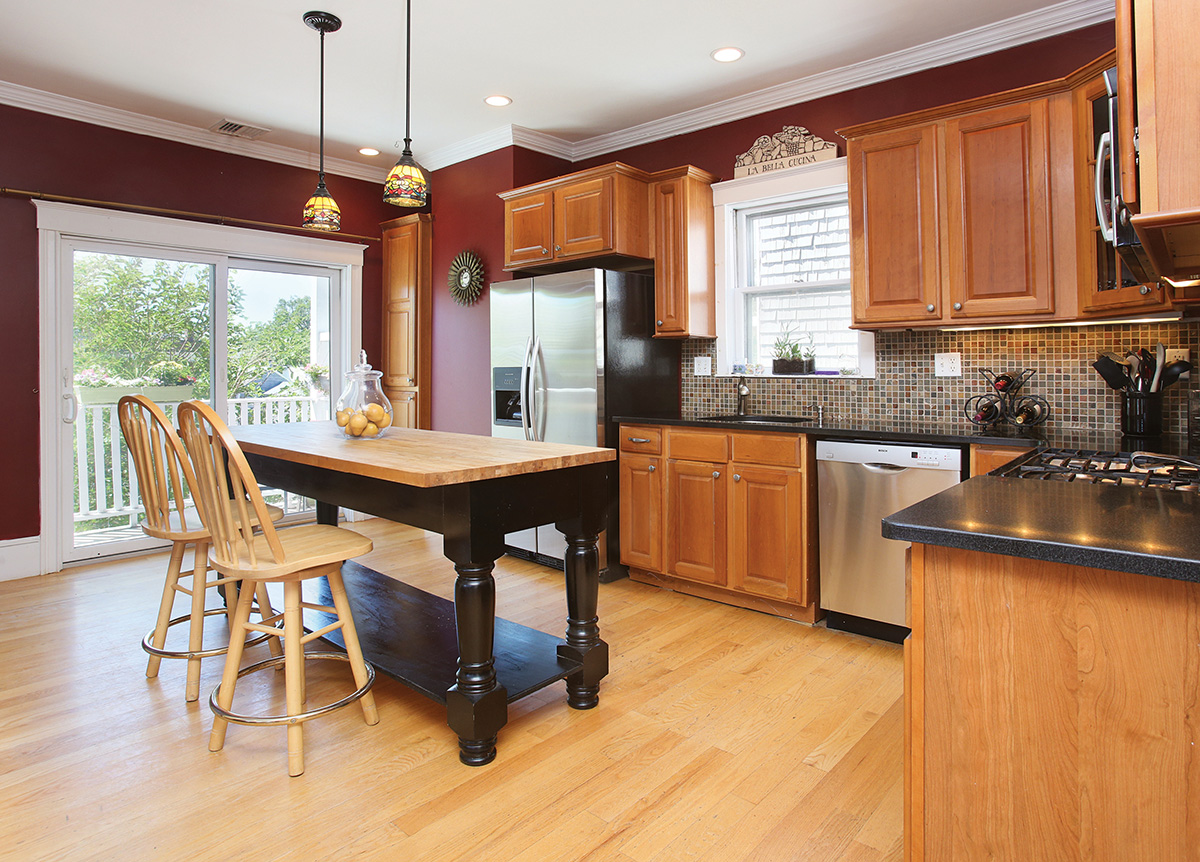
Photograph by Matt Murphy/Boston Virtual Imaging
Triple-Deckers
Also known locally as three-deckers, these multifamily abodes have long been staples in neighborhoods such as J.P. and Dorchester. Though practical, their front-facing decks can be stacked with patio furniture, bikes, and clutter—an immediate turnoff for buyers. “Very often, interior images are much nicer than exterior ones,” he says. “You don’t need to have exterior shots if they don’t help tell the home’s story.” To give the illusion of more space in tight quarters, Murphy advises against including more than two walls in a single shot. Removing superfluous personal items can also have this effect: “A livable kitchen…has a lot of stuff on the countertops, but you don’t sell a place the way that you live in it. There’s a certain stress that comes through in a photograph that’s filled with stuff.”
HOLD
Brookline
2015 Median Condo Price $700,000
2010 Median Condo Price $468,000
Five-Year Change 50%
Top public schools, T access, restaurants and stores galore—Brookline is always a good bet when it comes to real estate. “This is one of the most stable markets in Greater Boston,” Bates says. “You’ve got urban proximity with a suburban feel, so you’re going to see nothing but appreciation.” And because this market isn’t subject to the wild price hikes driven by new developments in the Seaport and downtown, it’s a particularly smart place to park yourself for the long term, whether in a condo or something larger: The median price for single-family homes has climbed 40 percent over five years, placing Brookline among the top 10 towns in the area for appreciation.
Prospect Hill, Somerville
2015 Median Condo Price $585,000
2010 Median Condo Price $355,000
Five-Year Change 65%
Spring Hill, Somerville
2015 Median Condo Price $599,900
2010 Median Condo Price $476,000
Five-Year Change 26%
Somerville is a perennially hot buy, and Prospect Hill and Spring Hill—once overlooked for Davis or Teele squares—keep getting better. If you were lucky enough to snag property in these hitherto underappreciated areas before the Green Line Extension chatter and Assembly Row construction began, consider yourself lucky and stay put. “Price per square foot continues to go up on condos, single-families, and multi-families,” says ePlace real estate agent Meghan Kellam. “Hold on for another year to see if the Green Line project is going to go forward and until more construction at Assembly Row happens.” Even if it doesn’t, real estate is still trending upward. “Since 2006 in Spring Hill alone, single-family-home prices went from $275 per square foot to $428 per square foot in 2015,” she says.
North Cambridge
2015 Median Condo Price $597,500
2010 Median Condo Price $370,000
Five-Year Change 61%
Real estate visionaries already own property in quieter North Cambridge, one of the few sections of the city poised for real estate growth thanks to its historically lower home values and development potential. It may lack the glitz factor of Kendall, but that’s exactly the point. “This is a great area to hold for future gains,” says Keller Williams real estate agent Ed Greable, particularly when you consider the office buildings and rental housing going into nearby Fresh Pond and the neighborhood’s proximity to the Alewife and Porter T stops. In 2010, the median condo price here was $370,000. In 2015, it was $597,500—and at this writing in 2016, it was already $650,000. Take it from Greable: “My client bought a Philly-style condo on Gold Star Road in 2012…for $355,000. Now it’s worth $550,000. In four years, it’s gone up $200,000. That’s a prime example of the growth in this neighborhood,” he says.
Love the One You’re With
Dysfunctional floor plan cramping your style? Sometimes all it takes is a change in perspective, and a few smart renovations, to make it work. Below, designer Liz Caan shows how she turned a diminutive, awkwardly configured Beacon Hill condo into a stylish and functional city retreat. —Brittany Jasnoff
Stats 2 bedrooms, 1.5 bathrooms, 1,000 square feet
Designer Liz Caan Interiors
Architect DesignCrossover
Contractor Richard Donovan
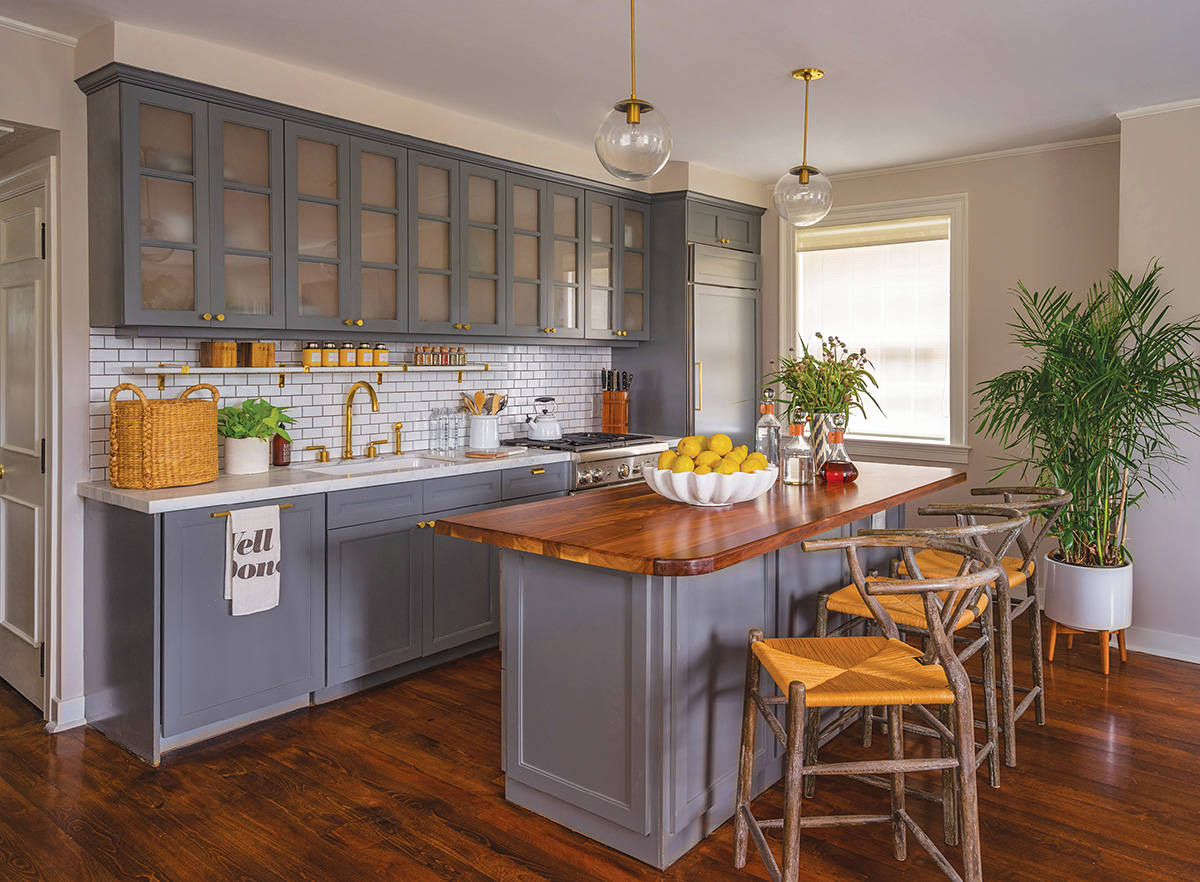
To create flow between the kitchen and the family room, the design team removed a wall of cabinets and a peninsula, which blocked traffic, and added a multifunctional island that does triple duty as a dining table, food-prep area, and desk.
Rather than go for typical finishes, Caan dressed up the kitchen with marble shelving, brass hardware, and cabinets painted in Benjamin Moore’s “Rocky Coast,” tying together the cooking area and the living space. “It feels a little warmer and less institutional,” she says.

“We wanted to create a little hallway before you get to the kitchen and dining room,” says Caan of the newly reconfigured foyer, which showcases a geometric Visual Comfort lantern. The designer also retrofitted an existing coat closet to accommodate a stacked washer-dryer and added more storage on the opposite side.
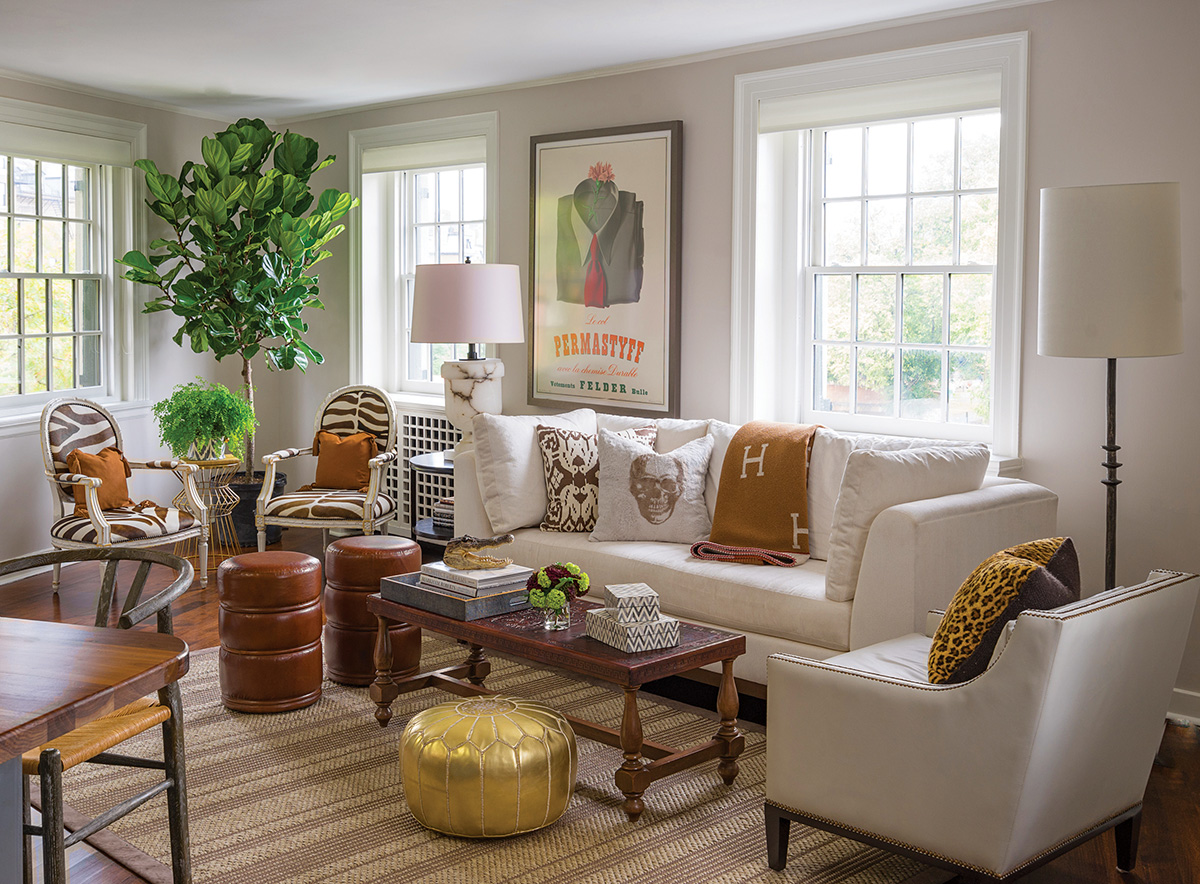
In the living area, Caan created two sitting areas—one for watching TV and one for reading—and chose smaller-scale furniture in lighter colors. “The space now feels much larger and flexible for entertaining,” she says.

The master bathroom was split into two, creating a powder room for dinner guests and adding value to the home in the process. Open-base vanities from Waterworks in both bathrooms “keep things open and airy,” Caan says.
Source, Median Price Data: Massachusetts Association of Realtors
